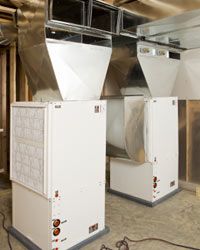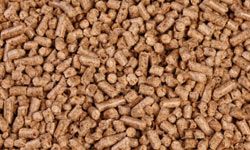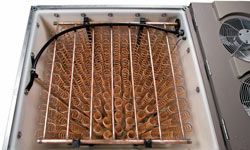Key Takeaways
- Innovative green technologies include geothermal systems, which use the Earth’s stable underground temperature to heat and cool homes efficiently.
- Solar power is split into passive systems, which design buildings to naturally control temperature without mechanical aid, and active systems, which use solar panels to generate energy for heating and cooling.
- Other technologies include biomass energy from organic materials, hydronic heating systems that circulate hot water or liquids for heating, and ice-powered air conditioners that use frozen water to reduce peak daytime electricity use.
Santa Clara University is not only a pantheon of learning in the heart of California's Silicon Valley, but it's also a temple of green technology. In April 2011, the university installed 60 rooftop solar collectors to heat and cool its student center. Engineers designed the large-scale array to run the building's hot water and air conditioning units [source: LaMonica].
The system is very efficient. The solar collectors grab the sun's rays and concentrate their captured energy, heating the building's water to 200 degrees. University officials expect the system to reduce the building's natural gas consumption by 70 percent each year and eliminate 34 tons of carbon dioxide from the atmosphere [source: LaMonica].
Advertisement
The university is leasing the system for 10 years, and during that time, it will pay a fixed price for the energy the solar array produces. The institution also received more than $86,000 in state rebates [source: Santa Clara University].
Santa Clara University is not alone in installing green heating and cooling systems. Other universities, businesses and homeowners are taking advantages of this green technology. Compared to standard heating and cooling systems, going green is better for the environment because it helps eliminate greenhouse gasses. In addition, the efficiency of these green systems allows people to save money on their energy bills, which has the potential to make a huge difference. According to the U.S. Department of Energy, heating and cooling account for 56 percent of a home's energy use [source: U.S. Department of Energy].
Green heating and cooling systems fall under two distinct categories: passive and active. Passive systems maximize nature's ability to heat and cool without furnaces or air conditioners [source: Green Technology]. Among other things, passive technology includes constructing homes with white or light-colored roofs that reflect the sun's energy instead of absorbing it. As a result, the amount of energy it takes to cool a house is less. Passive designs also use windows that can keep the heat out and cool air in [source: Build it Solar].
Active designs use a variety of mechanical heating and cooling systems. These systems run on solar power, geothermal power or other sources of green energy.
The uptick in green-energy use in recent years is slowly having an impact. For one thing, Americans saved more than $19 billion in 2008 by using various green heating and cooling systems [source: U.S. Department of Energy]. But these green systems are not cheap -- some solar collectors cost between $30 and $80 per square foot for installation. The government, however, has incentive programs to help builders and homeowners defray some of the cost [source: U.S. Department of Energy].
Go to the next page to read about the 10 best green heating and cooling options for your home.



